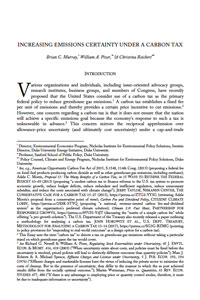Various organizations and individuals have proposed that the United States consider use of a carbon tax as the primary federal policy to reduce greenhouse gas emissions. A carbon tax establishes a fixed fee per unit of emissions and thereby provides a certain price incentive to cut emissions. However, one concern regarding a carbon tax is that it does not ensure that the nation will achieve a specific emissions goal because the economy’s response to such a tax is unknown in advance. Ultimately, there is an underlying tradeoff between certainty about emissions and certainty about prices and costs. Mechanisms that balance emissions and cost uncertainty can be viewed as a way to structure a more careful compromise between cost concerns and environmental interests. Under a carbon tax, mechanisms that can increase mitigation action may allow environmental constituencies to agree to what they may view as an environmentally risky tax with the assurance that further steps will be taken should emissions become too high. This symposium in the Harvard Environmental Law Review discusses a range of mechanisms that could increase emissions certainty under a carbon tax. It draws from recent discussions between the authors and other policy experts, and its goal is to define a set of options for deeper exploration. It begins with a discussion of how to measure emissions performance, or what it means to be achieving or not achieving an emissions goal, which could provide the basis for pursuing remedial mechanisms. Next, it presents a taxonomy of such mechanisms and the challenges and opportunities of each. Finally, it discusses ideas for initiating these mechanisms, either through some automated or discretionary procedure, and summarizes areas for additional research.
Nicholas Institute for Environmental Policy Solutions
Publisher


